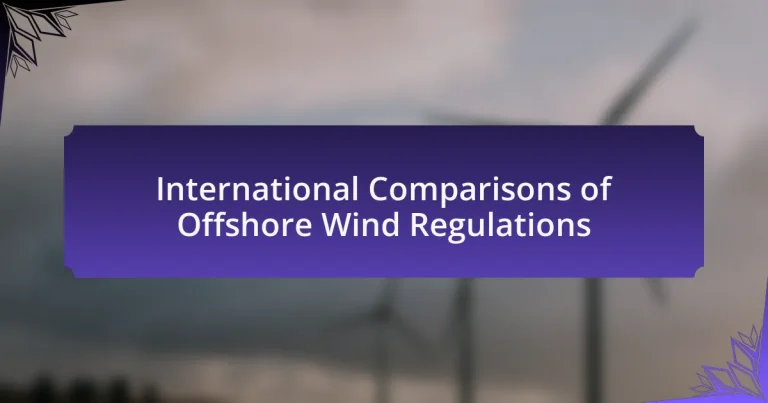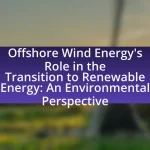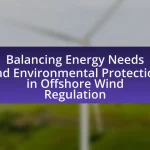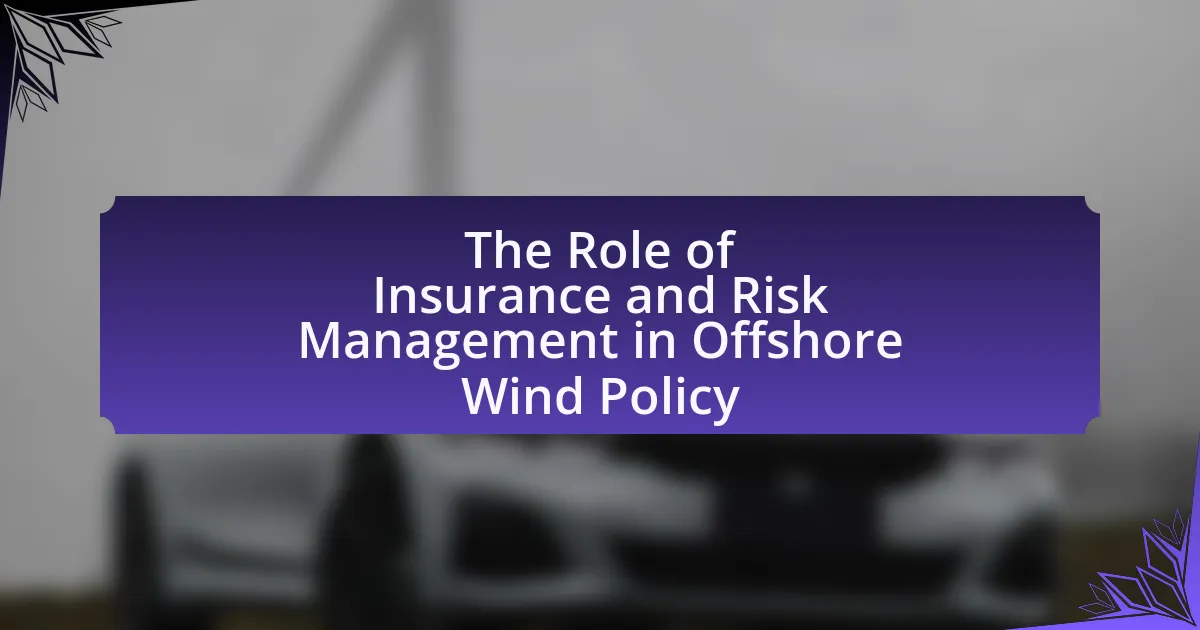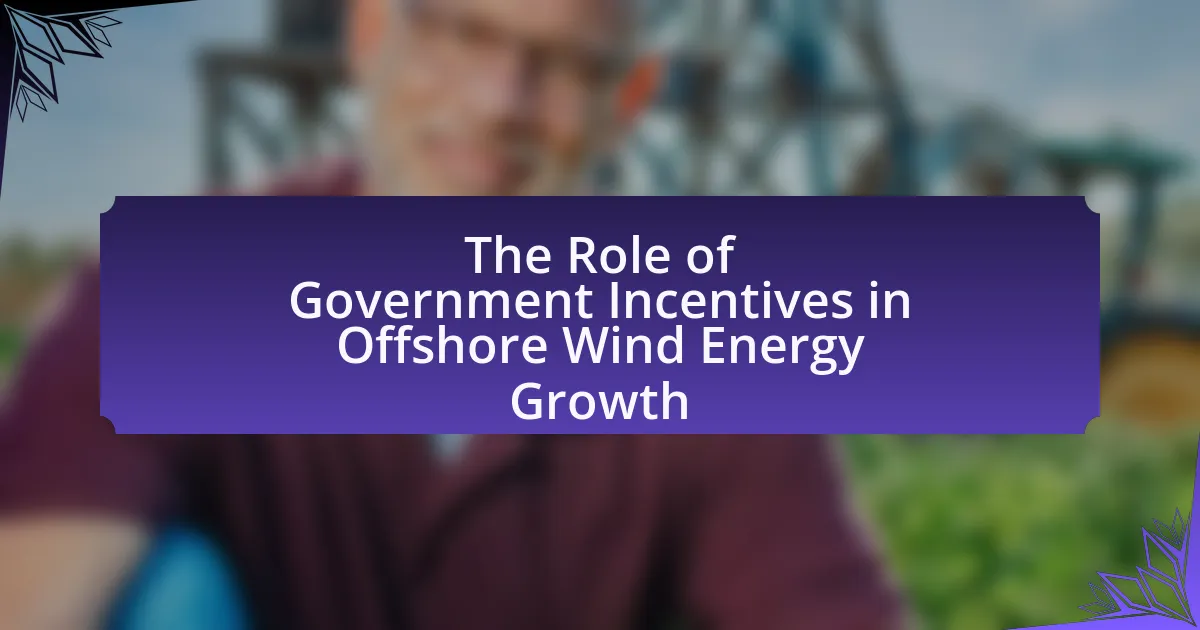Offshore wind regulations are essential legal frameworks that govern the development, operation, and maintenance of offshore wind energy projects, ensuring environmental protection and safety while facilitating renewable energy goals. This article provides an international comparison of offshore wind regulations, highlighting variations across countries such as the United Kingdom, Germany, and the United States, influenced by governmental policies, economic conditions, and cultural contexts. Key components of these regulations include permitting processes, environmental assessments, and safety standards, which collectively impact project timelines and costs. The article also discusses challenges in regulatory implementation, stakeholder interests, and emerging trends in technology and climate change that shape the future of offshore wind energy development.
What are Offshore Wind Regulations and Why are They Important?
Offshore wind regulations are legal frameworks and guidelines that govern the development, operation, and maintenance of offshore wind energy projects. These regulations are important because they ensure environmental protection, promote safety, and facilitate the orderly development of offshore wind resources, which are crucial for achieving renewable energy targets and reducing greenhouse gas emissions. For instance, the European Union has established directives that require member states to assess the environmental impact of offshore wind farms, ensuring that biodiversity is preserved while harnessing wind energy.
How do Offshore Wind Regulations vary internationally?
Offshore wind regulations vary significantly across countries, reflecting differences in governmental frameworks, environmental policies, and energy strategies. For instance, the European Union has established a comprehensive regulatory framework that emphasizes sustainability and environmental protection, while countries like the United States have a more fragmented approach, with regulations varying by state and federal jurisdiction. In the UK, the Crown Estate manages seabed leasing, which streamlines the process, whereas in Germany, a more centralized approach is taken through the Federal Maritime and Hydrographic Agency. These variations impact project timelines, permitting processes, and stakeholder engagement, illustrating how national priorities shape offshore wind development.
What factors influence the differences in Offshore Wind Regulations across countries?
Differences in Offshore Wind Regulations across countries are influenced by factors such as governmental policies, environmental considerations, economic conditions, and technological capabilities. Governmental policies shape the regulatory framework, with some countries prioritizing renewable energy development through supportive legislation, while others may impose stricter regulations due to environmental concerns. Economic conditions, including investment levels and market maturity, also play a crucial role; countries with robust financial backing tend to have more developed offshore wind sectors. Additionally, technological capabilities, such as the availability of advanced wind turbine technology and infrastructure, further differentiate regulatory approaches. For instance, countries like Denmark and Germany have established comprehensive regulatory frameworks that facilitate offshore wind development, while others may lag due to less favorable conditions.
How do cultural and economic contexts shape Offshore Wind Regulations?
Cultural and economic contexts significantly shape Offshore Wind Regulations by influencing public perception, investment priorities, and policy frameworks. For instance, countries with strong environmental values, such as Denmark, have established comprehensive regulations that promote renewable energy, resulting in a leading position in offshore wind capacity. Conversely, nations with less emphasis on environmental sustainability may adopt more lenient regulations, prioritizing economic growth over ecological concerns. Economic factors, such as the availability of financial resources and market demand for energy, also dictate the regulatory landscape; for example, the UK has implemented robust offshore wind policies supported by substantial government investment and incentives, leading to rapid industry growth. These cultural and economic influences create distinct regulatory environments that reflect each country’s unique priorities and challenges in offshore wind development.
What are the key components of Offshore Wind Regulations?
The key components of Offshore Wind Regulations include permitting processes, environmental assessments, safety standards, and grid connection requirements. Permitting processes establish the legal framework for project approval, ensuring compliance with local, national, and international laws. Environmental assessments evaluate the potential impacts on marine ecosystems and biodiversity, often mandated by legislation such as the National Environmental Policy Act in the United States. Safety standards are critical for protecting workers and the public, often guided by regulations from organizations like the Occupational Safety and Health Administration. Grid connection requirements dictate how offshore wind farms integrate with existing energy infrastructure, ensuring reliability and efficiency in energy distribution. These components collectively ensure that offshore wind projects are developed responsibly and sustainably.
What types of permits are required for Offshore Wind projects?
Offshore wind projects require several types of permits, including federal, state, and local permits. Specifically, the Bureau of Ocean Energy Management (BOEM) issues leases and permits for the construction and operation of offshore wind facilities in U.S. federal waters. Additionally, projects must obtain state-level permits, which can include environmental impact assessments and coastal zone management approvals. Local permits may also be necessary for construction activities and compliance with local regulations. These permitting processes ensure that offshore wind projects meet environmental, safety, and regulatory standards.
How do safety and environmental standards impact Offshore Wind Regulations?
Safety and environmental standards significantly shape Offshore Wind Regulations by establishing the criteria for operational safety and ecological protection. These standards ensure that offshore wind projects minimize risks to workers and the marine environment, leading to regulations that mandate safety assessments, environmental impact studies, and compliance with international treaties. For instance, the International Maritime Organization’s guidelines influence national regulations, requiring developers to adhere to strict safety protocols and environmental safeguards, which can include measures to protect marine life and habitats. Consequently, adherence to these standards not only promotes sustainable development but also enhances public acceptance and investment in offshore wind projects.
What challenges do countries face in implementing Offshore Wind Regulations?
Countries face several challenges in implementing Offshore Wind Regulations, including regulatory complexity, environmental concerns, and technological limitations. Regulatory complexity arises from the need to harmonize various national and local laws, which can lead to delays and inconsistencies in permitting processes. Environmental concerns involve assessing the impact of offshore wind farms on marine ecosystems, which requires extensive research and can complicate approval timelines. Technological limitations include the need for advanced infrastructure and grid integration, which can be costly and require significant investment. These challenges are evident in various countries, where differing regulatory frameworks and stakeholder interests can hinder the development of offshore wind projects.
How do regulatory frameworks affect project timelines and costs?
Regulatory frameworks significantly impact project timelines and costs by establishing the legal and procedural requirements that must be met before, during, and after project execution. These frameworks can introduce delays due to lengthy approval processes, compliance checks, and the need for public consultations, which can extend the overall timeline of a project. For instance, in the offshore wind sector, countries with streamlined regulatory processes, such as the United Kingdom, often see faster project deployment compared to those with more complex regulations, like Germany, where extensive environmental assessments can prolong timelines. Additionally, regulatory compliance can increase costs through the need for specialized legal and consulting services, as well as potential fines for non-compliance. A study by the International Renewable Energy Agency (IRENA) found that regulatory uncertainty can lead to cost increases of up to 20% in renewable energy projects, highlighting the financial implications of regulatory frameworks on project execution.
What role do stakeholder interests play in Offshore Wind Regulation challenges?
Stakeholder interests significantly influence Offshore Wind Regulation challenges by shaping policy decisions and regulatory frameworks. Various stakeholders, including government entities, environmental groups, local communities, and industry players, often have conflicting priorities that complicate the regulatory process. For instance, while industry stakeholders may advocate for expedited permitting to facilitate project development, environmental groups may push for stricter regulations to protect marine ecosystems. This dynamic can lead to delays in project approvals and increased costs, as seen in the United Kingdom, where stakeholder opposition has resulted in lengthy public consultations and modifications to proposed projects. Thus, the interplay of diverse stakeholder interests is a critical factor in the effectiveness and efficiency of offshore wind regulation.
How do Different Countries Approach Offshore Wind Regulations?
Different countries approach offshore wind regulations through varying frameworks that reflect their energy policies, environmental considerations, and economic goals. For instance, the United Kingdom has established a comprehensive regulatory framework that includes the Offshore Wind Sector Deal, which aims to increase offshore wind capacity to 40 GW by 2030, supported by streamlined planning processes and financial incentives. In contrast, Germany emphasizes environmental protection and has implemented stringent permitting processes that require extensive environmental impact assessments before project approval. The United States is evolving its regulatory approach, with the Bureau of Ocean Energy Management facilitating leasing processes while balancing state and federal interests, as seen in the recent approval of multiple offshore wind projects along the East Coast. These differences illustrate how national priorities shape offshore wind regulations, impacting project development timelines and investment attractiveness.
What are the leading countries in Offshore Wind development?
The leading countries in offshore wind development are China, the United Kingdom, and Germany. China has the largest installed capacity, with over 30 gigawatts as of 2023, significantly outpacing other nations. The United Kingdom follows with around 10 gigawatts, being a pioneer in offshore wind technology and deployment since the early 2000s. Germany ranks third, with approximately 8 gigawatts of installed capacity, contributing to its renewable energy goals. These countries have established robust regulatory frameworks and investment incentives that support the growth of offshore wind energy.
How do the United Kingdom’s Offshore Wind Regulations compare to those of Germany?
The United Kingdom’s offshore wind regulations are generally more streamlined and investor-friendly compared to Germany’s, which tend to be more complex and bureaucratic. The UK employs a system of Contracts for Difference (CfD) that provides price stability and encourages investment, while Germany’s Feed-in Tariff (FiT) system has faced criticism for its regulatory hurdles and slower permitting processes. Additionally, the UK has established a clear framework for spatial planning and environmental assessments, which facilitates quicker project approvals, whereas Germany’s regulations often involve multiple layers of governmental oversight, leading to longer timelines for project development.
What unique approaches does Denmark take in its Offshore Wind Regulations?
Denmark employs a unique approach in its offshore wind regulations by implementing a comprehensive and streamlined permitting process that emphasizes stakeholder engagement and environmental considerations. This regulatory framework includes a “one-stop-shop” model, which consolidates various permits and approvals into a single application process, significantly reducing administrative burdens for developers. Additionally, Denmark mandates extensive public consultations and environmental impact assessments, ensuring that local communities and ecological factors are integral to decision-making. This approach has facilitated the rapid expansion of offshore wind capacity, making Denmark a leader in the sector, with over 7,000 megawatts of installed offshore wind power as of 2023.
What lessons can be learned from international Offshore Wind Regulations?
International Offshore Wind Regulations provide critical lessons in harmonization, stakeholder engagement, and environmental protection. Countries with established offshore wind sectors, such as the United Kingdom and Germany, demonstrate the importance of standardized regulatory frameworks that facilitate project development while ensuring compliance with safety and environmental standards. For instance, the UK’s Offshore Wind Sector Deal emphasizes collaboration between government and industry, leading to streamlined permitting processes and reduced project timelines. Additionally, effective stakeholder engagement, as seen in Denmark’s approach, highlights the necessity of involving local communities and interest groups early in the planning stages to address concerns and foster public support. Lastly, robust environmental assessments, mandated in various jurisdictions, underscore the need for comprehensive studies to mitigate ecological impacts, as evidenced by regulations in the Netherlands that require thorough environmental impact assessments before project approval. These lessons collectively inform best practices for developing successful offshore wind initiatives globally.
How can best practices from one country be adapted to another’s regulatory framework?
Best practices from one country can be adapted to another’s regulatory framework by conducting a thorough analysis of the existing regulations, identifying key elements that contribute to successful outcomes, and tailoring those elements to fit the local context. For instance, the United Kingdom’s offshore wind regulatory framework emphasizes streamlined permitting processes and stakeholder engagement, which can be adapted by countries like the United States by simplifying their own permitting procedures and enhancing public consultation efforts. This approach is supported by the International Renewable Energy Agency, which highlights that regulatory alignment and stakeholder involvement are critical for the successful implementation of offshore wind projects.
What common pitfalls should countries avoid in Offshore Wind Regulation development?
Countries should avoid overly complex regulatory frameworks in Offshore Wind Regulation development. Simplifying regulations can enhance clarity and efficiency, facilitating investment and project implementation. For instance, the United Kingdom’s streamlined permitting process has been pivotal in accelerating offshore wind projects, leading to a significant increase in installed capacity. Additionally, countries should refrain from inconsistent policy changes, as seen in Germany, where frequent shifts have created uncertainty for investors. Maintaining stable and predictable regulations fosters a conducive environment for long-term investments in offshore wind energy.
What Future Trends are Emerging in Offshore Wind Regulations?
Future trends in offshore wind regulations include increased standardization across jurisdictions, enhanced environmental assessments, and a focus on technological innovation. Standardization aims to streamline permitting processes, making it easier for developers to navigate regulations in different countries. Enhanced environmental assessments are becoming crucial as stakeholders demand more rigorous evaluations of ecological impacts, driven by public concern and policy shifts towards sustainability. Additionally, regulations are increasingly encouraging the adoption of advanced technologies, such as floating wind turbines, to expand the viability of offshore wind projects in deeper waters. These trends reflect a global movement towards more efficient, environmentally responsible, and technologically advanced offshore wind energy development.
How is technology influencing Offshore Wind Regulations?
Technology is significantly influencing offshore wind regulations by enabling more efficient energy production and enhancing safety measures. Advanced technologies such as predictive analytics, remote monitoring, and automated systems allow for better site assessments, operational efficiency, and maintenance practices. For instance, the integration of digital twin technology helps in simulating and optimizing wind farm performance, which informs regulatory frameworks to ensure compliance with environmental and safety standards. Additionally, innovations in turbine design and materials have led to increased energy output and reduced costs, prompting regulators to adapt policies that encourage investment and development in offshore wind projects.
What role do innovations in turbine design play in regulatory changes?
Innovations in turbine design significantly influence regulatory changes by driving the need for updated standards that ensure safety, efficiency, and environmental protection. As turbine technology advances, such as the development of larger and more efficient models, regulators must adapt existing frameworks to address new operational parameters and potential impacts on marine ecosystems. For instance, the introduction of floating wind turbines has prompted revisions in maritime regulations to accommodate their unique anchoring and operational requirements, ensuring compliance with safety and environmental guidelines. This dynamic interaction between technological advancements and regulatory frameworks is essential for fostering sustainable offshore wind development while mitigating risks associated with new technologies.
How are digital tools shaping compliance and monitoring in Offshore Wind projects?
Digital tools are significantly enhancing compliance and monitoring in Offshore Wind projects by enabling real-time data collection and analysis. These tools facilitate the tracking of regulatory requirements and performance metrics, ensuring adherence to environmental and safety standards. For instance, the use of remote sensing technologies and drones allows for continuous monitoring of turbine conditions and environmental impacts, which helps in maintaining compliance with international regulations. Additionally, software platforms that aggregate and analyze data from various sources improve transparency and accountability, making it easier for stakeholders to demonstrate compliance to regulatory bodies.
What are the implications of climate change on Offshore Wind Regulations?
Climate change significantly impacts offshore wind regulations by necessitating stricter environmental assessments and adaptive management practices. As sea levels rise and extreme weather events become more frequent, regulatory frameworks must evolve to ensure the resilience and sustainability of offshore wind projects. For instance, the European Union’s Renewable Energy Directive emphasizes the need for comprehensive environmental impact assessments that account for climate-related risks, thereby influencing national regulations across member states. Additionally, the International Energy Agency reports that integrating climate change considerations into regulatory processes can enhance the long-term viability of offshore wind energy, ensuring that projects are designed to withstand changing environmental conditions.
How are countries adapting their regulations to meet climate goals?
Countries are adapting their regulations to meet climate goals by implementing stricter emissions standards, promoting renewable energy sources, and enhancing energy efficiency measures. For instance, the European Union has established the European Green Deal, which aims to make Europe the first climate-neutral continent by 2050, mandating significant reductions in greenhouse gas emissions. Additionally, countries like Denmark and Germany have set ambitious offshore wind targets, with Denmark planning to produce 70% of its energy from renewable sources by 2030. These regulatory adaptations are supported by international agreements such as the Paris Agreement, which encourages nations to set and achieve specific climate targets, thereby reinforcing the need for regulatory changes to facilitate the transition to sustainable energy systems.
What impact does public opinion on climate change have on Offshore Wind Regulations?
Public opinion on climate change significantly influences offshore wind regulations by shaping policy decisions and regulatory frameworks. When public concern about climate change rises, governments are more likely to implement supportive policies for renewable energy, including offshore wind projects. For instance, surveys indicate that in countries like Germany and the UK, where public support for climate action is high, there has been a corresponding increase in investment and regulatory support for offshore wind energy. This correlation is evident in the UK’s commitment to expand its offshore wind capacity to 40 gigawatts by 2030, driven by public demand for cleaner energy sources.
What best practices can be adopted for effective Offshore Wind Regulation?
Effective offshore wind regulation can be achieved by adopting best practices such as establishing clear permitting processes, engaging stakeholders early, and implementing adaptive management strategies. Clear permitting processes streamline approvals and reduce uncertainty, as seen in countries like Denmark, where a well-defined regulatory framework has facilitated rapid project deployment. Engaging stakeholders, including local communities and environmental groups, fosters transparency and builds public support, which is evidenced by successful projects in Germany that incorporated extensive public consultation. Lastly, adaptive management strategies allow for ongoing assessment and adjustment of regulations based on new data and technological advancements, a practice that has proven effective in the United Kingdom, where regulations evolve in response to industry feedback and environmental monitoring.
How can stakeholder engagement improve Offshore Wind regulatory processes?
Stakeholder engagement can improve Offshore Wind regulatory processes by fostering collaboration and transparency among all parties involved. Engaging stakeholders, including local communities, environmental groups, and industry representatives, ensures that diverse perspectives are considered, leading to more informed decision-making. For instance, studies have shown that projects with active stakeholder involvement experience fewer delays and conflicts, as seen in the UK’s Offshore Wind Sector Deal, which emphasizes collaboration to streamline regulatory approvals. This approach not only enhances public trust but also aligns regulatory frameworks with societal needs and environmental considerations, ultimately facilitating smoother project implementation.
What strategies can enhance the efficiency of Offshore Wind project approvals?
Streamlining the regulatory framework is a key strategy to enhance the efficiency of Offshore Wind project approvals. Simplifying permitting processes, reducing bureaucratic hurdles, and establishing clear guidelines can significantly decrease approval times. For instance, countries like Denmark have implemented a one-stop-shop approach, allowing developers to navigate all necessary permits through a single entity, which has led to faster project initiation and completion. Additionally, early stakeholder engagement and transparent communication can mitigate conflicts and expedite decision-making, as evidenced by successful projects in Germany where proactive community involvement has led to smoother approvals.
